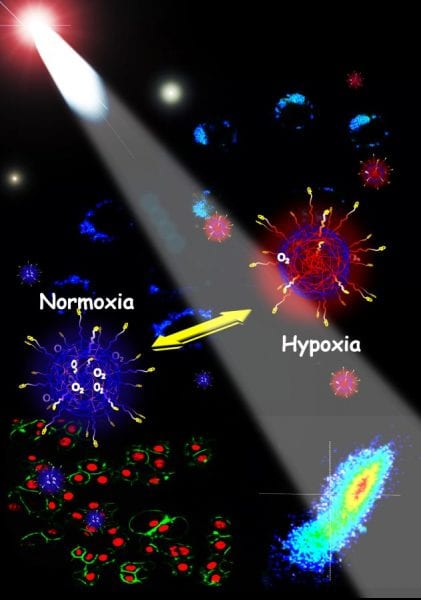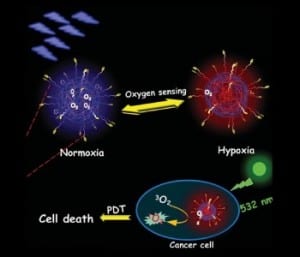 Phosphorescent conjugated polymer dots (Pdots) are developed for cancer cell imaging and therapy. In their approach, researchers from Nanjing, China attach Pt(II) porphyrin complexes to a water soluble polymer. These Pdots are able to quantitatively detect low oxygen levels (hypoxia) in tumor cells and can serve as a potent agent for photodynamic therapy in solid tumors.
Phosphorescent conjugated polymer dots (Pdots) are developed for cancer cell imaging and therapy. In their approach, researchers from Nanjing, China attach Pt(II) porphyrin complexes to a water soluble polymer. These Pdots are able to quantitatively detect low oxygen levels (hypoxia) in tumor cells and can serve as a potent agent for photodynamic therapy in solid tumors.
Photodynamic therapy is a minimally invasive technique in which singlet oxygen is created to selectively induce cell death. This is realized by introducing photosensitizer molecules into the tumor tissue. Upon irradiation, the photosensitizer, Pt(II) porphyrin, generates singlet oxygen. The presented Pdots show differences in their phosphorescence properties at different oxygen concentrations. As hypoxia is characteristic for several diseases including solid tumors, Pdots have the potential to be used in tumor detection. Additionally, hypoxia can be detected at early stages of cancer, which makes Pdots highly interesting for their use in early-stage cancer diagnostics and therapy.
The transition metal complex Pt(II) porphyrin is suitable as an agent for photodynamic therapy due to its high singlet oxygen quantum yield. Its biocompatibility is enhanced by attaching it to a water-soluble polyfluorene-based hyperbranched conjugated polyelectrolyte. A great advantage of Pdots for tumor detection is the reduced interference of background fluorescence. At time-resolved detection, the phosphorescence of the Pdots can be selectively detected.
Advanced Science is a new journal from the team behind Advanced Materials, Advanced Functional Materials, and Small. The journal is fully Open Access and is free to read now at www.advancedscience.com.

















